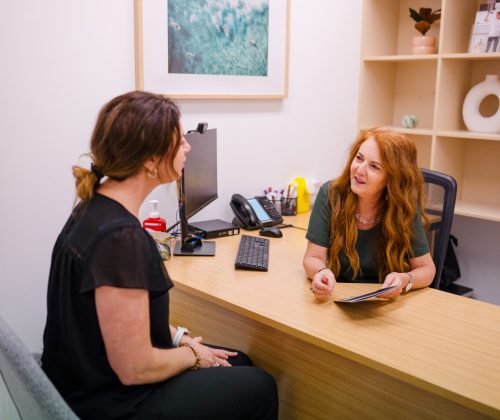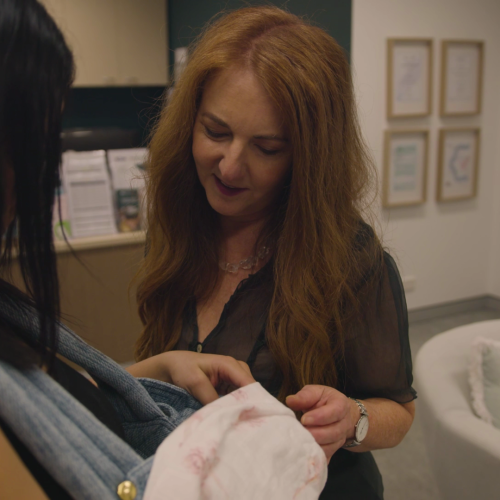IVF
Dr Jenny Cook | Sydney Gynaecologist & Advanced Laparoscopic Surgeon
What sets me apart?
I have worked in the fertility space for 25 years. I work as part of an amazing team of experienced and compassionate fertility nurses. I have a very close relationship with the skilled and caring embryologists. We always discuss each individual treatment plan to ensure that it is optimised. We check every step of the treatment plan.
We all care about you and your individual journey. We are all there to answer any of your questions or address any concerns. I will guide you through this every step of the way. I am there personally for your egg collection and your embryo transfer.

IVF Overview
This process takes place over a woman’s 4 week menstrual cycle.
Week 1–2: Controlled Ovarian Stimulation
IVF takes place over a woman’s 4 week menstrual cycle. Injections are taken taken for about 10-12 days to stimulate the ovaries to mature a group of follicles (containing the eggs). It seems overwhelming to give yourself injections but you will be shown how to do this in a detailed education session with one of our fertility nurses. And don’t be afraid to ask questions. No question is too big or too small. If you have problems, we are available 24 hours per day to answer your questions.
You will go to one of our early morning clinics a few times in the first two weeks. This is to check your ovaries (with a pelvic ultrasound) and to check your hormones (with a blood test). This is done by one of our fertility nurses. You will be called in the afternoon to let you know how you are progressing.
Generally after you have taken the injections for about 12 days, your ovaries are ready and we can prepare for the egg collection. You are given a trigger injection so that the eggs will go through the final maturation process.
End of Week 2: Egg Collection & Semen Collection
Your male partner will be asked to provide a sperm sample at the embryology lab. This is on the day of egg collection. If you are using donor sperm, this is thawed on the day of the egg collection.
Week 2–3: Fertilisation & Embryo Growth
The progress of the embryos over the next 5 to 6 days is carefully recorded by an embryoscope. Photos are taken of the development of the embryos. This gives the embryologists the opportunity to select the best embryo to use later when you come back in for an embryo transfer. You will be contacted regularly to update you on the progress of your embryos.
Week 3: Embryo Transfer & Storage
Week 4: Pregnancy Test
There is then a 9 day wait before the pregnancy test. During this time do not do anything to overheat – such as a spa or sauna. We also recommend that you don’t do anything to force water up at high pressures – such as bungee jumping or waterskiing! I imagine that most women aren’t planning those activities in the days after an embryo transfer.
You will have a pregnancy test after 9 days. You can call us at anytime during this period if you need to. We are always around. We understand that this waiting time can be very stressful.
Finally, we always aim for a positive result. And this is wonderful if it happens the first time. But if it is not a positive result, I am there to talk you through the next steps and to encourage you to keep going. I am there to be supportive because I understand the emotional rollercoaster which can happen when you are going through fertility treatment. We will always look at different things which can be done to get you a positive result.
Genetic testing of embryos
Monash IVF has a state-of-the-art genetics lab and offers several genetic testing options and support with in-house counsellors. Genetic testing is not required for everyone. I can talk to you about whether it is right for you.
To perform genetic testing on an embryo, the embryologist will remove (biopsy) a small number of cells (~ 5-7 cells) from the embryo once it reaches the blastocyst stage (about Day 5 of development). The cells which are biopsied are those that would contribute to the placenta. The embryos are then cryopreserved while the biopsied cells are sent for genetic testing.
There are different genetic tests which are available. PGT-A (Pre-implantation Genetic Testing – Aneuploidy) refers to the most common test which looks to see that the embryo has the correct number of chromosomes. PGT-M (Monogene) is testing for a specific gene mutation such as cystic fibrosis. PGT-SR (Structural Rearrangement) is a test looking for a structural rearrangement of a chromosome.

PIEZO-ICSI
This is a modified version of ICSI which is currently only offered in Australia by Monash IVF but is used extensively elsewhere around the world. Unlike traditional ICSI, which uses a sharp needle to inject sperm into the egg, PIEZO-ICSI employs a blunt needle combined with micro-vibrating motions to inject the sperm. This gentler approach reduces the risk of damaging the egg’s delicate outer membrane. In select patient groups we have found that PIEZO-ICSI shows improved outcomes compared to traditional ICSI.
I can talk to you about this option and whether this is a benefit to you.
ICSI (Intra-cytoplasmic Sperm Injection)
ICSI is a technique the scientists use to fertilise the egg when conventional insemination is not recommended during an IVF cycle. Indications for use of ICSI include when there are too few sperm or there is poor sperm motility in a sample. The scientist selects the best sperm and then injects it directly into the egg for fertilization.
Explore IVF treatment tailored to you.
With over 25 years of experience, Dr Jenny provides personalised, compassionate IVF care from your first consultation, to egg collection and embryo transfer. She personally performs all your procedures and works closely with her dedicated team to guide you through every step.
